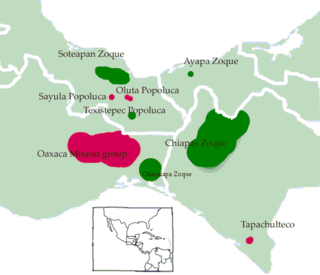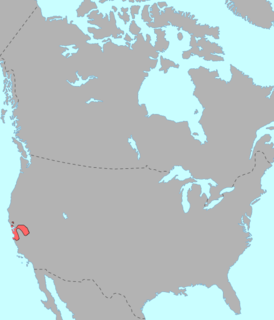Related Research Articles

The North Caucasian languages, sometimes called simply Caucasic, is a proposed language family consisting of a pair of well established language families spoken in the Caucasus, predominantly in the north, consisting of the Northwest Caucasian family and the Northeast Caucasian family.
The Sko or Skou languages are a small language family spoken by about 7000 people, mainly along the Vanimo coast of Sandaun Province in Papua New Guinea, with a few being inland from this area and at least one just across the border in the Indonesian province of Papua.
In linguistic typology, ergative–absolutive alignment is a type of morphosyntactic alignment in which the single argument ("subject") of an intransitive verb behaves like the object of a transitive verb, and differently from the agent of a transitive verb. Examples are Basque, Georgian, Mayan, Tibetan, a few Indo-European languages and, to some degree, the Semitic modern Aramaic languages.

The color chocolate is a tone of dark brown that resembles chocolate. At right is displayed the color traditionally called chocolate.

Chitimacha is a language isolate historically spoken by the Chitimacha people of Louisiana, United States. It became extinct in 1940 with the death of the last fluent speaker, Delphine Ducloux.
Proto–Afroasiatic, sometimes referred to as Proto-Afrasian, is the reconstructed proto-language from which all modern Afroasiatic languages are descended. Though estimations vary widely, it is believed by scholars to have been spoken as a single language around 12,000 to 18,000 years ago, that is, between 16,000 and 10,000 BC. The reconstruction of Proto-Afroasiatic is problematic and remains largely lacking. Moreover, no consensus exists as to the location of the Afroasiatic Urheimat, the putative homeland of Proto-Afroasiatic speakers.
The Ramu–Lower Sepika.k.a.Lower Sepik–Ramu languages are a proposed family of about 35 Papuan languages spoken in the Ramu and Sepik river basins of northern Papua New Guinea. These languages tend to have simple phonologies, with few consonants or vowels and usually no tones.

The Mixe–Zoque languages are a language family whose living members are spoken in and around the Isthmus of Tehuantepec, Mexico. The Mexican government recognizes three distinct Mixe–Zoquean languages as official: Mixe or ayook with 188,000 speakers, Zoque or o'de püt with 88,000 speakers, and the Popoluca languages of which some are Mixean and some Zoquean with 69,000 speakers. However the internal diversity in each of these groups is great and the Ethnologue counts 17 different languages, and the current classification of Mixe–Zoquean languages by Wichmann (1995) counts 12 languages and 11 dialects. Extinct languages classified as Mixe–Zoquean include Tapachultec, formerly spoken on Tapachula, along the southeast coast of Chiapas.
Itonama is a moribund language isolate spoken by the Itonama people in the Amazonian lowlands of north-eastern Bolivia. Greenberg’s (1987) classification of Itonama as Paezan, a sub-branch of Macro-Chibchan, remains unsupported and Itonama continues to be considered an isolate or unclassified language.

Tlapanec, or Meꞌphaa, is an indigenous Mexican language spoken by more than 98,000 Tlapanec people in the state of Guerrero. Like other Oto-Manguean languages, it is tonal and has complex inflectional morphology. The ethnic group themselves refer to their ethnic identity and language as Me̱ꞌpha̱a̱.
Texistepec, commonly called either Texistepec Popoluca or Texistepec Zoque, is a Mixe–Zoquean language of the Zoquean branch spoken by a hundred indigenous Popoluca people in and around the town of Texistepec in Southern Veracruz, Mexico.

Southern Sierra Miwok is a Utian language spoken by the Native American people called the Southern Sierra Miwok of Northern California. Southern Sierra Miwok is a member of the Miwok language family along with Lake Miwok, Coast Miwok (extinct), Saclan (extinct), Plains Miwok (extinct), Northern Sierra Miwok and Central Sierra Miwok. The Miwok languages are a part of the larger Penutian language stock. The original territory of the Southern Sierra Miwok people is similar to modern day Mariposa County, California. The Southern Sierra Miwok language is nearly extinct with only a few speakers existing today. However, as of 2012, an active revitalization program is underway.
Søren Wichmann is a Danish linguist specializing in historical linguistics, linguistic typology, Mesoamerican languages, and epigraphy. Since June 2016, he has been employed as a University Lecturer at Leiden University Centre for Linguistics, Leiden University, after having worked at different institutions in Denmark, Mexico, Germany and Russia, including, during 2003-2015, the Department of Linguistics, Max Planck Institute for Evolutionary Anthropology.

Totozoquean is a proposed language family of Mesoamerica, originally consisting of two well-established genetic groupings, Totonacan and Mixe–Zoque. The erstwhile isolate Chitimacha was later proposed to be a member. The closest relatives of Totozoquean may be the Huavean languages.
Kaki Ae, or Tate, is a language with about 500 speakers, half the ethnic population, near Kerema, in Papua New Guinea. It was previously known by the foreign designation Raeta Tati.
Molof is a poorly documented Papuan language spoken by about 200 people in Molof village, Senggi District, Keerom Regency.
The Automated Similarity Judgment Program (ASJP) is a collaborative project applying computational approaches to comparative linguistics using a database of word lists. The database is open access and consists of 40-item basic-vocabulary lists for well over half of the world's languages. It is continuously being expanded. In addition to isolates and languages of demonstrated genealogical groups, the database includes pidgins, creoles, mixed languages, and constructed languages. Words of the database are transcribed into a simplified standard orthography (ASJPcode). The database has been used to estimate dates at which language families have diverged into daughter languages by a method related to but still different from glottochronology, to determine the homeland (Urheimat) of a proto-language, to investigate sound symbolism, to evaluate different phylogenetic methods, and several other purposes.
The South Pauwasi languages are a likely small language family of New Guinea, potentially consisting of Yetfa, Kimki, Lepki, Murkim and Kembra.
The Northwest Papuan languages are a proposed language family of Papuan languages.
The Lepki–Murkim languages are a pair to three recently discovered languages of New Guinea, Lepki, Murkim and possibly Kembra.
References
- Wichmann, Søren (2005). "Tlapanec Cases" (PDF). In Rosemary Beam de Azcona; Mary Paster (eds.). Report 13, Survey of California and Other Indian Languages. Conference on Otomanguean and Oaxacan Languages, March 19–21, 2004. Berkeley CA: University of California at Berkeley. pp. 133–145. Archived from the original on November 2, 2014. Retrieved 2011-03-01.CS1 maint: unfit URL (link)